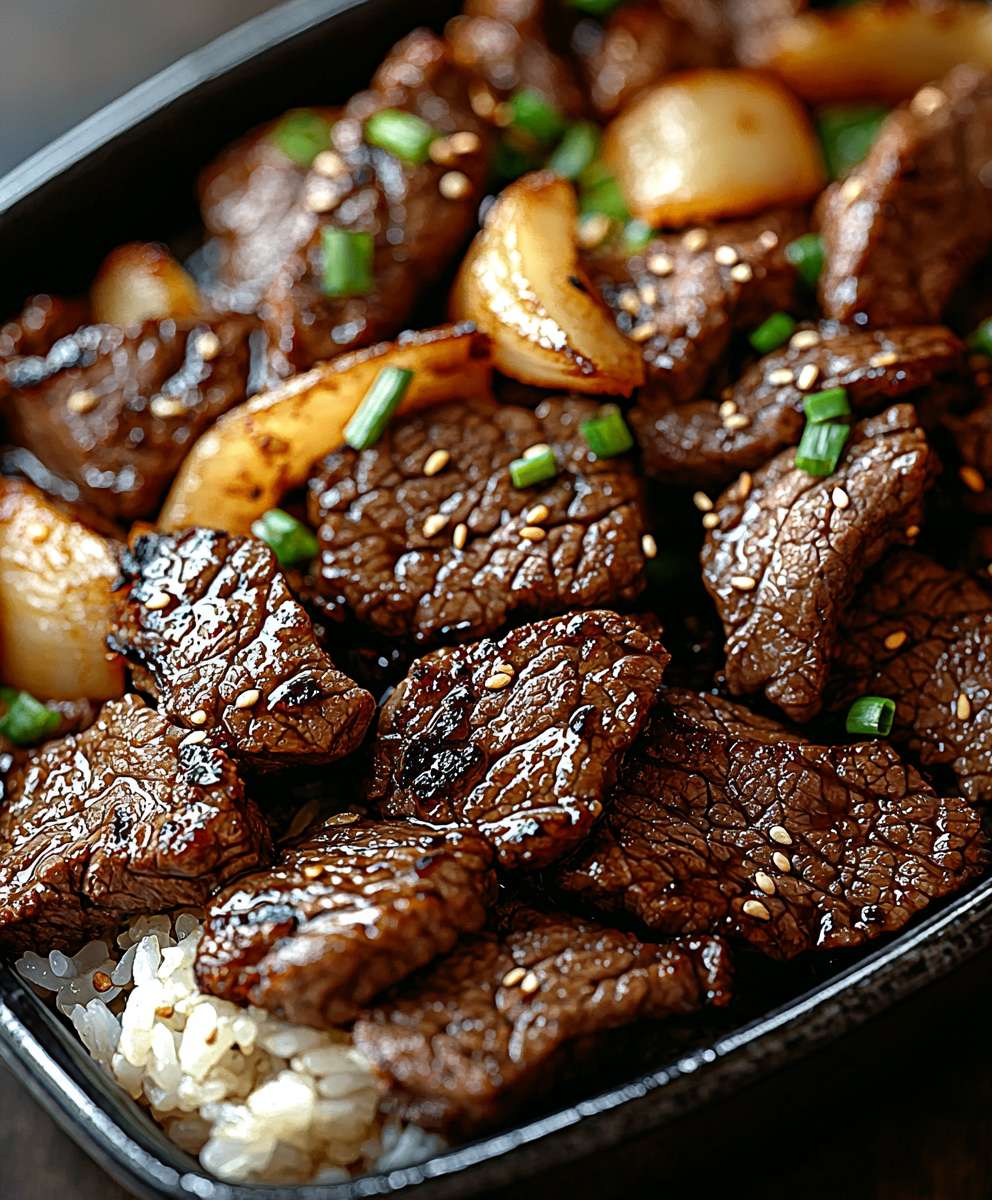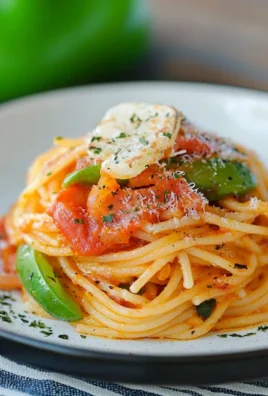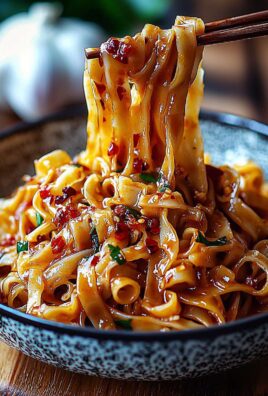Beef Bulgogi, the mere mention of it conjures images of sizzling, marinated perfection, doesn’t it? Imagine tender, thinly sliced beef, infused with a sweet and savory sauce, caramelizing to a delightful crisp on the edges. It’s a dish that’s both incredibly satisfying and surprisingly easy to make at home, and I’m thrilled to share my foolproof recipe with you.
Bulgogi, meaning “fire meat” in Korean, boasts a rich history deeply intertwined with Korean culture. Originating as a dish enjoyed by royalty and the upper class, it has evolved into a beloved staple enjoyed by everyone. Its popularity has transcended borders, captivating food lovers worldwide with its irresistible flavor profile.
What makes Beef Bulgogi so universally appealing? It’s a symphony of flavors the umami-rich soy sauce, the sweetness of the pear and brown sugar, the subtle tang of sesame oil, and the gentle warmth of garlic and ginger. The thin slices of beef ensure a quick cooking time and a melt-in-your-mouth texture. Whether you’re looking for a quick weeknight dinner or a dish to impress your guests, Bulgogi is always a winning choice. Its incredibly versatile, perfect served with rice, tucked into lettuce wraps, or even added to tacos for a fusion twist. Get ready to embark on a culinary adventure that will tantalize your taste buds and leave you craving more!

Ingredients:
- 1.5 lbs thinly sliced ribeye or sirloin steak (partially frozen for easier slicing)
- ½ cup soy sauce
- ¼ cup brown sugar, packed
- 3 tablespoons sesame oil
- 2 tablespoons rice wine vinegar
- 2 tablespoons Asian pear puree (or apple puree as a substitute)
- 1 tablespoon minced garlic
- 1 tablespoon grated ginger
- 1 teaspoon black pepper
- 1 medium onion, thinly sliced
- 2 green onions, thinly sliced
- 1 tablespoon sesame seeds, toasted
- Vegetable oil, for cooking
- Cooked rice, for serving
- Optional garnishes: kimchi, lettuce leaves, ssamjang (Korean dipping sauce)
Preparing the Bulgogi Marinade:
Okay, let’s get started with the heart of this dish: the marinade! This is where all the magic happens, infusing the beef with that signature sweet and savory bulgogi flavor. Trust me, don’t skimp on the marinating time; it makes a world of difference.
- Combine the Wet Ingredients: In a medium-sized bowl, whisk together the soy sauce, brown sugar, sesame oil, rice wine vinegar, and Asian pear puree (or apple puree). Make sure the brown sugar is fully dissolved. This forms the base of our flavor profile, balancing salty, sweet, and tangy notes.
- Add the Aromatics: Now, stir in the minced garlic, grated ginger, and black pepper. These aromatics are crucial for that authentic bulgogi taste. Don’t be shy with the garlic and ginger; they really elevate the dish.
- Taste and Adjust (Optional): Give the marinade a taste. If you prefer a sweeter bulgogi, add a little more brown sugar. If you want a bit more tang, add a splash more rice wine vinegar. Remember, you can always adjust to your personal preference!
Marinating the Beef:
This is the most important step! The longer you marinate the beef, the more flavorful and tender it will become. I usually aim for at least 2 hours, but overnight is even better.
- Prepare the Beef: If your steak isn’t already thinly sliced, partially freeze it for about 30-45 minutes. This makes it much easier to slice thinly against the grain. Aim for slices that are about 1/8 inch thick. This thinness is key for quick cooking and maximum flavor absorption.
- Combine Beef and Marinade: In a large bowl or resealable plastic bag, combine the thinly sliced beef with the prepared marinade. Make sure all the beef is evenly coated. Gently massage the marinade into the beef to ensure it penetrates all the fibers.
- Add the Onions: Add the thinly sliced onion to the bowl or bag. The onions will not only add flavor but also help to tenderize the beef further.
- Marinate: Seal the bag or cover the bowl tightly with plastic wrap. Refrigerate for at least 2 hours, or preferably overnight. The longer the better, but don’t exceed 24 hours, as the marinade can start to break down the beef too much.
Cooking the Bulgogi:
Now for the fun part: cooking! Bulgogi is traditionally cooked over a grill, but you can also easily cook it in a skillet or wok on the stovetop. I’ll give you instructions for both methods.
Grilling Instructions:
- Preheat the Grill: Preheat your grill to medium-high heat. Make sure the grates are clean and lightly oiled to prevent sticking.
- Grill the Beef: Remove the beef from the marinade, letting any excess drip off. Grill the beef in a single layer, being careful not to overcrowd the grill. Overcrowding will lower the temperature and cause the beef to steam instead of sear.
- Cook Quickly: Cook for about 1-2 minutes per side, or until the beef is cooked through and slightly caramelized. The thin slices will cook very quickly, so keep a close eye on them to prevent burning.
- Remove and Rest: Remove the cooked bulgogi from the grill and let it rest for a few minutes before serving. This allows the juices to redistribute, resulting in more tender and flavorful beef.
Stovetop Instructions:
- Heat the Skillet or Wok: Heat a large skillet or wok over medium-high heat. Add a tablespoon or two of vegetable oil.
- Cook the Beef in Batches: Remove the beef from the marinade, letting any excess drip off. Cook the beef in batches, being careful not to overcrowd the pan. Overcrowding will lower the temperature and cause the beef to steam instead of sear.
- Stir-Fry: Stir-fry the beef for about 2-3 minutes per batch, or until it’s cooked through and slightly caramelized. Keep the beef moving in the pan to ensure even cooking.
- Remove and Set Aside: Remove the cooked bulgogi from the skillet or wok and set it aside. Repeat with the remaining beef.
Final Touches and Serving:
Almost there! Now it’s time to add the finishing touches and serve up this delicious bulgogi. I love to serve it with rice and various Korean side dishes, but you can customize it to your liking.
- Add Green Onions and Sesame Seeds: Once all the beef is cooked, return it to the skillet or wok (if using the stovetop method). Add the thinly sliced green onions and toasted sesame seeds. Toss everything together to combine.
- Serve Immediately: Serve the bulgogi immediately over cooked rice.
- Optional Garnishes: Garnish with kimchi, lettuce leaves, and ssamjang (Korean dipping sauce) for a complete and authentic Korean meal. You can also add other vegetables like sautéed mushrooms or carrots.
- Lettuce Wraps (Ssam): A popular way to eat bulgogi is to wrap it in lettuce leaves with rice, kimchi, and ssamjang. This is called “ssam” and it’s a fun and interactive way to enjoy the dish.
Tips and Variations:
Want to customize your bulgogi? Here are a few tips and variations to try:
- Spice it Up: Add a pinch of red pepper flakes or a tablespoon of gochujang (Korean chili paste) to the marinade for a spicy kick.
- Add Vegetables: Sauté some sliced mushrooms, carrots, or bell peppers and add them to the bulgogi during the last few minutes of cooking.
- Use Different Cuts of Beef: While ribeye and sirloin are traditional, you can also use other cuts of beef like flank steak or skirt steak. Just make sure to slice them thinly against the grain.
- Make it Vegetarian: Substitute the beef with tofu or mushrooms for a vegetarian version. Marinate the tofu or mushrooms in the same marinade and cook as directed.
- Bulgogi Bowls: Create a bulgogi bowl by layering rice, bulgogi, and your favorite toppings like kimchi, pickled vegetables, and a fried egg.
- Freezing Instructions: You can freeze the marinated beef for up to 3 months. Thaw it in the refrigerator overnight before cooking.
Enjoy your homemade Beef Bulgogi! I hope you found this recipe helpful and easy to follow. Let me know in the comments if you have any questions or if you try any of the variations. Happy cooking!

Conclusion:
This isn’t just another recipe; it’s an invitation to experience the vibrant flavors of Korea right in your own kitchen. I truly believe this Beef Bulgogi recipe is a must-try for anyone who loves delicious, easy-to-make meals. The combination of savory, sweet, and slightly spicy notes creates a symphony of taste that will have you coming back for seconds (and thirds!). The marinade, with its perfect balance of soy sauce, sesame oil, garlic, and ginger, transforms simple slices of beef into a culinary masterpiece. Its a dish thats both comforting and exciting, familiar yet uniquely satisfying. But what truly elevates this recipe is its versatility. While I’ve presented it as a classic stir-fry, the possibilities are endless! Imagine serving it over a bed of fluffy white rice, the savory juices soaking into each grain. Or, try wrapping it in crisp lettuce leaves with a dollop of ssamjang (Korean spicy dipping sauce) for a refreshing and healthy lettuce wrap. For a heartier meal, consider adding it to a warm bowl of bibimbap, complete with a fried egg and an array of colorful vegetables. And don’t be afraid to experiment with variations! If you’re feeling adventurous, add a pinch of gochugaru (Korean chili powder) to the marinade for an extra kick. For a sweeter flavor, a touch more brown sugar or honey can do the trick. You can also swap out the beef for chicken or pork, adjusting the cooking time accordingly. Vegetarian? Tofu works beautifully as well! Just press it to remove excess water and marinate it for at least 30 minutes before cooking. The beauty of this Beef Bulgogi recipe lies in its adaptability. It’s a blank canvas for your culinary creativity. Whether you’re a seasoned cook or a beginner in the kitchen, I’m confident that you’ll be able to create a dish that you’ll be proud of. Its a fantastic weeknight meal that comes together quickly, but its also impressive enough to serve to guests. Trust me, the aroma alone will have everyone drooling! I’ve poured my heart and soul into perfecting this recipe, and I’m so excited for you to try it. I truly believe it captures the essence of authentic Korean cuisine while remaining accessible and easy to prepare. So, gather your ingredients, put on some music, and get ready to embark on a culinary adventure. I can’t wait to hear about your experience! Did you try any variations? What did you serve it with? What did your family and friends think? Please, share your thoughts and photos in the comments below. Your feedback is invaluable, and it helps me continue to create and share recipes that you’ll love. Don’t be shy let me know how your Beef Bulgogi turned out! Happy cooking! Print
Beef Bulgogi: The Ultimate Guide to Korean BBQ at Home
- Total Time: 30 minutes
- Yield: 4–6 servings 1x
Description
Sweet and savory Korean BBQ beef (Bulgogi) made with thinly sliced ribeye or sirloin marinated in a flavorful blend of soy sauce, sesame oil, garlic, and ginger. Perfect for grilling or stovetop cooking and served with rice and your favorite Korean side dishes.
Ingredients
- 1.5 lbs thinly sliced ribeye or sirloin steak (partially frozen for easier slicing)
- ½ cup soy sauce
- ¼ cup brown sugar, packed
- 3 tablespoons sesame oil
- 2 tablespoons rice wine vinegar
- 2 tablespoons Asian pear puree (or apple puree as a substitute)
- 1 tablespoon minced garlic
- 1 tablespoon grated ginger
- 1 teaspoon black pepper
- 1 medium onion, thinly sliced
- 2 green onions, thinly sliced
- 1 tablespoon sesame seeds, toasted
- Vegetable oil, for cooking
- Cooked rice, for serving
- Optional garnishes: kimchi, lettuce leaves, ssamjang (Korean dipping sauce)
Instructions
- Prepare the Bulgogi Marinade: In a medium-sized bowl, whisk together the soy sauce, brown sugar, sesame oil, rice wine vinegar, and Asian pear puree (or apple puree). Make sure the brown sugar is fully dissolved.
- Stir in the minced garlic, grated ginger, and black pepper.
- Taste and adjust the marinade to your preference, adding more brown sugar for sweetness or rice wine vinegar for tang.
- Marinate the Beef: If your steak isn’t already thinly sliced, partially freeze it for about 30-45 minutes. This makes it much easier to slice thinly against the grain. Aim for slices that are about 1/8 inch thick.
- In a large bowl or resealable plastic bag, combine the thinly sliced beef with the prepared marinade. Make sure all the beef is evenly coated. Gently massage the marinade into the beef to ensure it penetrates all the fibers.
- Add the thinly sliced onion to the bowl or bag.
- Seal the bag or cover the bowl tightly with plastic wrap. Refrigerate for at least 2 hours, or preferably overnight (but no more than 24 hours).
- Grilling Instructions: Preheat your grill to medium-high heat. Make sure the grates are clean and lightly oiled to prevent sticking.
- Remove the beef from the marinade, letting any excess drip off. Grill the beef in a single layer, being careful not to overcrowd the grill.
- Cook for about 1-2 minutes per side, or until the beef is cooked through and slightly caramelized.
- Remove the cooked bulgogi from the grill and let it rest for a few minutes before serving.
- Stovetop Instructions: Heat a large skillet or wok over medium-high heat. Add a tablespoon or two of vegetable oil.
- Remove the beef from the marinade, letting any excess drip off. Cook the beef in batches, being careful not to overcrowd the pan.
- Stir-fry the beef for about 2-3 minutes per batch, or until it’s cooked through and slightly caramelized. Keep the beef moving in the pan to ensure even cooking.
- Remove the cooked bulgogi from the skillet or wok and set it aside. Repeat with the remaining beef.
- Final Touches and Serving: Once all the beef is cooked, return it to the skillet or wok (if using the stovetop method). Add the thinly sliced green onions and toasted sesame seeds. Toss everything together to combine.
- Serve the bulgogi immediately over cooked rice.
- Garnish with kimchi, lettuce leaves, and ssamjang (Korean dipping sauce) for a complete and authentic Korean meal. You can also add other vegetables like sautéed mushrooms or carrots.
- A popular way to eat bulgogi is to wrap it in lettuce leaves with rice, kimchi, and ssamjang. This is called “ssam” and it’s a fun and interactive way to enjoy the dish.
Notes
- Marinating the beef for at least 2 hours, or preferably overnight, is crucial for flavor and tenderness.
- Thinly slicing the beef is essential for quick cooking and maximum flavor absorption. Partially freezing the beef makes it easier to slice thinly.
- Don’t overcrowd the grill or skillet when cooking the beef, as this will cause it to steam instead of sear.
- Adjust the marinade to your personal preference by adding more brown sugar for sweetness or rice wine vinegar for tang.
- For a spicy kick, add a pinch of red pepper flakes or a tablespoon of gochujang (Korean chili paste) to the marinade.
- You can freeze the marinated beef for up to 3 months. Thaw it in the refrigerator overnight before cooking.
- Prep Time: 20 minutes
- Cook Time: 10 minutes




Leave a Comment